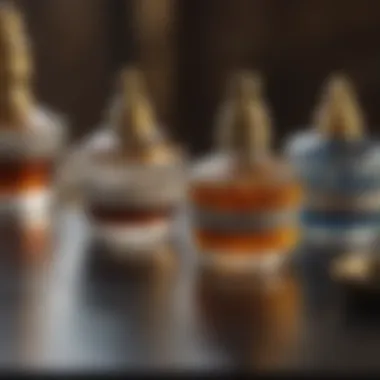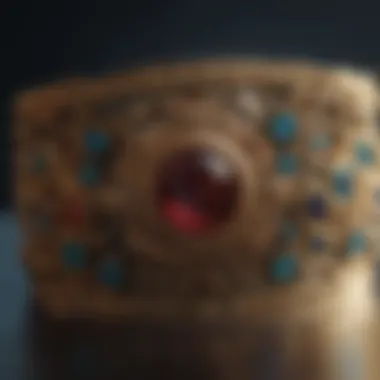Discover the Top Glues for Jewelry Repair That Guarantee Lasting Results


The Ins and Outs of Selecting the Perfect Glue for Jewellery Repair
This comprehensive guide aims to delve into the complexities of choosing the ideal adhesive for jewelry repair, shedding light on the critical aspects that can make or break the restoration process. Whether you are faced with mending a delicate chain or reattaching a precious gemstone, the significance of selecting the right glue cannot be overstated. By exploring the various options available, understanding their unique features, and mastering the application techniques, you can make an informed decision that will not only maintain but enhance the beauty and longevity of your beloved pieces.
Types of Adhesives for Jewellery Repair
In the realm of jewellery repair, various types of adhesives cater to different needs and materials. From cyanoacrylate-based super glues to epoxy resin adhesives, each variant offers distinct properties that determine its suitability for specific repair tasks. Understanding the characteristics of each type is crucial in ensuring a successful and enduring fix, avoiding common pitfalls such as discoloration, brittleness, or inadequate bonding strength.
Cyanoacrylate-Based Super Glues
Widely recognized for their rapid bonding and ease of use, cyanoacrylate-based super glues are a popular choice for quick fixes and precise applications. Their fast-drying nature makes them ideal for immediate repairs, while their strong adhesive properties ensure a reliable bond between surfaces. However, it is essential to note that these glues may not be suitable for all materials and can sometimes result in a brittle finish that is less forgiving to movements and stresses.
Epoxy Resin Adhesives
Renowned for their versatility and strength, epoxy resin adhesives offer a more durable and resilient bonding solution for jewellery repairs. Comprising two components that must be mixed before application, epoxy adhesives provide a longer working time, allowing for meticulous positioning of pieces before the adhesive sets. This feature makes them ideal for complex repairs or situations where alignment precision is paramount. Additionally, epoxy resins boast excellent adhesion to a wide range of materials, including metals, gemstones, and ceramics, making them a versatile choice for diverse repair needs.
Application Techniques for Optimal Results
While selecting the right adhesive is crucial, mastering the application techniques is equally important to achieve a flawless and long-lasting repair. Each type of adhesive requires specific handling and application methods to maximize its bonding strength and ensure a seamless finish. Whether you are working with delicate chains, intricate settings, or fragile gemstones, following best practices can significantly enhance the durability and aesthetics of your repair work.
Surface Preparation
Before applying any adhesive, it is essential to prepare the surfaces to be bonded meticulously. Ensure that the surfaces are clean, dry, and free of any residue or contaminants that may hinder proper adhesion. Depending on the materials involved, surface treatment techniques such as sanding, degreasing, or roughening may be necessary to promote better bonding.
Application Precision
Precision is key when applying adhesives to jewellery pieces, especially in intricate or small-scale repairs. Use precise tools such as precision applicators or toothpicks to apply the adhesive sparingly and accurately to the bonding surfaces. Avoid excess glue that can seep out or create unsightly residues, as it may compromise the aesthetics and durability of the repair.
Final Thoughts: Perfection in Every Repair
In the realm of jewellery repair, the choice of adhesive can make a world of difference in the longevity and quality of the restoration work. By understanding the nuances of different adhesive options, mastering their application techniques, and adhering to best practices, you can elevate your repair skills to new heights and preserve the beauty and integrity of your cherished jewellery pieces for years to come.
Understanding the Importance of Quality Glue in Jewellery Repair
Repairing jewellery requires meticulous attention to detail, showcasing the significance of selecting the right adhesive. The glue used in jewellery repair plays a crucial role in ensuring a lasting and seamless fix for your treasured pieces. Without the appropriate adhesive, even the most intricate repairs may not hold up over time. Quality glue not only bonds the components together effectively but also ensures that the repaired piece retains its beauty and integrity, standing the test of time.


Factors to Consider When Selecting Glue for Jewellery Repair
Type of Material Being Repaired
Choosing the correct glue depends largely on the material you are repairing. Different materials such as metal, glass, or gemstones require specific adhesives tailored to their properties. For example, metals may require a strong bonding agent to withstand regular wear, while delicate gemstones may need a gentler adhesive to avoid damage during the repair process. Understanding the material being repaired is essential for selecting the most appropriate glue that will ensure a successful and long-lasting repair.
Strength and Durability Requirements
The strength and durability of the glue are paramount considerations when selecting an adhesive for jewellery repair. The adhesive must be able to withstand the various forces and pressures that the jewellery piece may encounter, ensuring that the repair remains intact under normal wear conditions. Durability is essential to prevent the need for frequent repairs, preserving the quality and longevity of the repaired item.
Transparency and Finish
The transparency and finish of the glue can significantly impact the aesthetics of the repaired jewellery. Opting for a transparent adhesive ensures that the glue line remains discreet, blending seamlessly with the material to maintain the piece's visual appeal. Additionally, choosing a glue with a finish that matches the original jewellery surface helps achieve a professional and flawless repair outcome.
Ease of Application
The ease of applying the glue influences the efficiency and precision of the repair process. An adhesive that is user-friendly, with proper applicator tools or easy-to-follow instructions, simplifies the repair task, even for those with limited experience in jewellery repair. Smooth application can also help prevent accidental spills or excess glue that may mar the appearance of the repaired piece.
Drying Time
The drying time of the glue is a critical factor in jewellery repairs, especially for intricate pieces with multiple components. Opting for a glue that offers a balance between adequate drying time for adjustments and quick curing to expedite the repair process is key. Proper drying time ensures that the adhesive sets correctly, enhancing the bond strength and overall quality of the repair.
Resistance to Water and Chemicals
Selecting a glue with resistance to water and chemicals is essential, particularly for jewellery pieces that may come into contact with liquids or cleaning agents. Choosing an adhesive that can withstand exposure to water and common cleaning substances ensures the longevity of the repair, preventing premature deterioration or weakening of the bond.
Reviews of Top Glues for Jewellery Repair
When it comes to repairing jewellery, the choice of glue plays a critical role in ensuring a lasting and seamless fix. Understanding the key features and considerations of different types of glue is paramount to preserving the beauty and integrity of your beloved pieces. In this article, we will delve into detailed reviews of the top glues commonly used in jewellery repair, providing valuable insights to help you make an informed decision.
1. Super Glue (Cyanoacrylate)
Strengths and Limitations
Super Glue, also known as Cyanoacrylate, is renowned for its quick bonding properties and high strength. Its ability to create durable bonds on various materials such as metal, glass, and plastic makes it a popular choice for jewellery repair. However, one must be cautious as its fast drying nature can lead to instant adhesion, leaving little room for adjustment.
Best Applications


The versatility of Super Glue makes it ideal for bonding small parts, such as reattaching small gemstones or fixing delicate chains. Its precision applicator allows for controlled dispensing, ensuring precise application even in tight spaces. However, due to its strong bonding capabilities, it may not be suitable for larger surface areas that require repositioning.
Recommended Products
Some recommended Super Glue products for jewellery repair include "Brand A Super Glue - Precision Applicator" and "Brand B Super Glue Gel - Impact Resistant." These products offer varying viscosities and drying times, catering to different repair needs.
2. Epoxy Resin
Strengths and Limitations
Epoxy Resin is known for its exceptional bonding strength and versatility. Its ability to bond a wide range of materials, including metal, ceramics, and stones, makes it an ideal choice for more substantial repairs. However, epoxy resin typically requires a curing period, which may prolong the repair process.
Best Applications
Epoxy Resin is best suited for repairs that require a strong and durable bond, such as fixing broken metal clasps or securing large embellishments. Its ability to fill gaps and withstand varying temperatures further enhances its utility in intricate jewellery repairs.
Recommended Products
"Brand X Epoxy Resin - 5-Minute Cure" and "Brand Y Epoxy Resin - Crystal Clear Finish" are highly recommended products known for their reliable bonding strength and crystal-clear appearance post-curing.
3. Jeweller's Cement
Strengths and Limitations
Jeweller's Cement is specifically formulated for jewellery applications, offering a balance between bonding strength and precision. Its non-drip formula ensures controlled application, preventing excess glue from marring your intricate pieces. However, its slower drying time may require additional clamping and patience during the repair process.
Best Applications
Ideal for precise repairs that demand accuracy, such as securing tiny embellishments or reattaching intricate components. Jeweller's Cement provides a clean and professional finish without compromising the delicate details of your jewellery.
Recommended Products
"Brand Z Jeweller's Cement - Extra Fine Tip" and "Brand W Jeweller's Cement - Non-Yellowing Formula" are recommended choices known for their fine applicator tips and long-lasting adhesion.
4. UV Resin


Strengths and Limitations
UV Resin offers ultra-fast curing times when exposed to ultraviolet light, making it a convenient choice for quick jewellery repairs. Its ability to cure on demand allows for precise bonding without the risk of premature drying. However, prolonged exposure to UV light may be necessary for thicker applications.
Best Applications
Recommended for repairs that require instant curing, such as securing transparent gemstones or creating resin coatings. UV Resin's clear finish and minimal shrinkage make it an attractive option for blending seamlessly with delicate jewellery pieces.
Recommended Products
"Brand P UV Resin - Transparent Finish" and "Brand Q UV Resin - Low Odor Formula" are popular choices known for their ease of use and rapid curing properties.
5. Acrylic Adhesive
Strengths and Limitations
Acrylic Adhesive, also known as acrylic glue, offers a balance between strength and flexibility, making it suitable for a variety of repairs. Its ability to bond different materials efficiently and withstand impacts ensures a reliable and durable repair. However, acrylic adhesive may have a longer drying time compared to instant adhesives.
Best Applications
Commonly used for bonding non-porous materials such as glass, metal, and plastics, Acrylic Adhesive is ideal for repairs requiring structural support and longevity. Its ability to provide a strong yet flexible bond accommodates movement without compromising the integrity of the repair.
Recommended Products
"Brand R Acrylic Adhesive - Impact Resistant" and "Brand S Acrylic Adhesive - Fast Cure" offer reliable bonding strength and versatile applications, catering to various jewellery repair needs.
Conclusion
In the realm of jewellery repair, the significance of choosing the best glue cannot be overstated. The success of a repair often hinges on the adhesive used, making it a critical decision for preserving the beauty and functionality of precious pieces. Through this detailed guide, readers have gained valuable insights into the various factors to consider when selecting a suitable glue for jewellery repair, ensuring a lasting and seamless outcome.
Final Thoughts on Choosing the Best Glue for Jewellery Repair
Balancing Strength and Precision
Balancing strength and precision is a crucial aspect when it comes to selecting the ideal glue for jewellery repair. This balance ensures that the adhesive provides a secure hold without compromising the delicate intricacies of the piece being repaired. The key characteristic of this balance lies in its ability to offer both durability and finesse, making it a popular choice among craftsmen and hobbyists alike. By striking the right balance between strength and precision, artisans can effectively repair jewellery with confidence, knowing that the bond will withstand the test of time. However, it's important to note that achieving this equilibrium may require practice and experimentation to perfect the technique.
Consideration for Long-Term Durability
Considering the long-term durability of the adhesive is essential in the jewellery repair process. A glue that offers lasting strength and resilience ensures that the repaired piece remains intact and functional for years to come. The key characteristic of prioritizing durability is its ability to withstand daily wear and tear, ensuring that the repair maintains its integrity over time. While opting for a durable adhesive may necessitate a longer setting time or specialized application techniques, the peace of mind in knowing that the repair will last is invaluable.
Personal Preference and Experience
Personal preference and experience play a significant role in the glue selection process for jewellery repair. Each artisan may have a preferred type of adhesive based on their past experiences and comfort levels with certain products. Personal preference can also stem from factors such as ease of use, odor, or cleanup methods associated with the glue. Additionally, experienced craftsmen may choose a specific adhesive based on the intricacy of the repair or the materials involved. While personal preference and experience can guide the choice of glue, it's essential to remain open to exploring new options and techniques to enhance the repair process and achieve optimal results.







